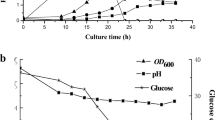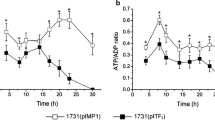Abstract
This study elucidated the importance of two critical enzymes in the regulation of butanol production in Clostridium acetobutylicum ATCC 824. Overexpression of both the 6-phosphofructokinase (pfkA) and pyruvate kinase (pykA) genes increased intracellular concentrations of ATP and NADH and also resistance to butanol toxicity. Marked increases of butanol and ethanol production, but not acetone, were also observed in batch fermentation. The butanol and ethanol concentrations were 29.4 and 85.5 % higher, respectively, in the fermentation by double-overexpressed C. acetobutylicum ATCC 824/pfkA+pykA than the wild-type strain. Furthermore, when fed-batch fermentation using glucose was carried out, the butanol and total solvent (acetone, butanol, and ethanol) concentrations reached as high as 19.12 and 28.02 g/L, respectively. The reason for improved butanol formation was attributed to the enhanced NADH and ATP concentrations and increased tolerance to butanol in the double-overexpressed strain.








Similar content being viewed by others
Abbreviations
- hsdR :
-
Host-specific restriction deficient
- mcrA :
-
Methylcytosine-specific restriction deleted
- recA1 :
-
Homologous recombination deleted
- endA1 :
-
Endonuclease deleted
- p15A ori :
-
p15 origin of replication
- Cmr :
-
Chloramphenicol resistance
- Φ3TI:
-
B. subtilis phage Φ3TI methyltransferase gene
- ColE1:
-
ColE1 origin of replication
- pIM13:
-
pIM13 gram-positive origin of replication
- Apr :
-
Ampicillin resistance
- MLSr :
-
Macrolide-lincosamide-streptogramin B resistance
- P-ptb :
-
Clostridial phosphate butyryltransferase promoter
- ctfA/B :
-
Acetoacetyl-CoA transferase genes
- adc :
-
AADC gene
- pfkA :
-
6-phosphofuctokinase gene
- pykA :
-
Pyruvate kinase gene
References
Alsaker KV, Spitzer TR, Papoutsakis ET (2004) Transcriptional analysis of spo0A overexpression in Clostridium acetobutylicum and its effect on the cell's response to butanol stress. J Bacteriol 186:1959–1971. doi:10.1128/JB.186.7.1959-1971.2004
Amador-Noguez D, Brasg IA, Feng X, Roquet N, Rabinowitz JD (2011) Metabolome remodeling during the acidogenic–solventogenic transition in Clostridium acetobutylicum. Appl Environ Microbiol 77:7984–7997
Annous BA, Blaschek HP (1991) Isolation and characterization of Clostridium acetobutylicum mutants with enhanced amylolytic activity. Appl Environ Microbiol 57:2544–2548
Ausubel FM, Brent R, Kingston RE, Moore DD, Seidman JD, Smith JA, Struhl K (1987) Current protocols in molecular biology. Green Publishing Associates/Wiley-Interscience, New York
Belouski E, Watson DE, Bennett GN (1998) Cloning, sequence, and expression of the phosphofructokinase gene of Clostridium acetobutylicum ATCC 824 in Escherichia coli. Curr Microbiol 37:17–22
Cooksley CM, Zhang Y, Wang H, Redl S, Winzer K, Minton NP (2012) Targeted mutagenesis of the Clostridium acetobutylicum acetone–butanol–ethanol fermentation pathway. Metab Eng 14:630–641
Desai RP, Harris LM, Welker NE, Papoutsakis ET (1999) Metabolic flux analysis elucidates the Importance of the acid-formation pathways in regulating solvent production by Clostridium acetobutylicum. Metab Eng 1:206–213
Dürre P (2008) Fermentative butanol production bulk chemical and biofuel. Ann NY Acad Sci 1125:353–362. doi:10.1196/annals.1419.009
Gottwald M, Gottschalk G (1985) The internal pH of Clostridium acetobutylicum and its effect on the shift from acid to solvent formation. Arch Microbiol 143:42–46
Green EM, Boynton ZL, Harris LM, Rudolph FB, Papoutsakis ET, Bennett GN (1996) Genetic manipulation of acid formation pathways by gene inactivation in Clostridium acetobutylicum ATCC 824. Microbiol 142:2079–2086
Harris LM, Desai RP, Welker NE, Papoutsakis ET (2000) Characterization of recombinant strains of the Clostridium acetobutylicum butyrate kinase inactivation mutant: need for new phenomenological models for solventogenesis and butanol inhibition? Biotechnol Bioeng 67:1–11
Hartmanis MGN, Gatenbeck S (1984) Intermediary metabolism in Clostridium acetobutylicum: levels of enzymes involved in the formation of acetate and butyrate. Appl Environ Microbiol 47:1277–1283
Hüsemann MHW, Papoutsakis ET (1989) Comparison between in vivo and in vitro enzyme activities in continuous and batch fermentations of Clostridium acetobutylicum. Appl Microbiol Biotechnol 30:585–595
Jang Y, Lee JY, Lee J, Park JH, Im JA, Eom M, Lee J, Lee S, Song H, Cho J (2012) Enhanced Butanol Production Obtained by Reinforcing the Direct Butanol-Forming Route in Clostridium acetobutylicum. mBio 3(5):1–9. doi:10.1128/mBio.00314-12
Jones DT, Woods DR (1986) Acetone–butanol fermentation revisited. Microbiol Rev 50(4):484–524
Lan EI, Liao JC (2012) ATP drives direct photosynthetic production of 1-butanol in cyanobacteria. Proc Natl Acad Sci 109:6018–6023
Lee SY, Park JH, Jang SH, Nielsen LK, Kim J, Jung KS (2008) Fermentative butanol production by clostridia. Biotechnol Bioeng 101:209–228
Lehmann D, Hönicke D, Ehrenreich A, Schmidt M, Weuster-Botz D, Bahl H, Lütke-Eversloh T (2012) Modifying the product pattern of Clostridium acetobutylicum. Appl Microbiol Biotechnol 94:743–754
Lütke-Eversloh T, Bahl H (2011) Metabolic engineering of Clostridium acetobutylicum: recent advances to improve butanol production. Curr Opin Biotechnol 22:634–647
Mann MS, Lütke–Eversloh T (2013) Thiolase engineering for enhanced butanol production in Clostridium acetobutylicum. Biotechnol Bioeng 110:887–897
Mann MS, Dragovic Z, Schirrmacher G, Lütke-Eversloh T (2012) Over-expression of stress protein-encoding genes helps Clostridium acetobutylicum to rapidly adapt to butanol stress. Biotechnol Lett 34:1643–1649
Mao S, Luo Y, Zhang T, Li J, Bao G, Zhu Y, Chen Z, Zhang Y, Li Y, Ma Y (2010) Proteome reference map and comparative proteomic analysis between a wild type Clostridium acetobutylicum DSM 1731 and its mutant with enhanced butanol tolerance and butanol yield. J proteome res 9:3046–3061
Mermelstein L, Papoutsakis E (1993) In vivo methylation in Escherichia coli by the Bacillus subtilis phage phi 3T I methyltransferase to protect plasmids from restriction upon transformation of Clostridium acetobutylicum ATCC 824. Appl Environ Microbiol 59:1077–1081
Meyer CL, Papoutsakis ET (1989) Increased levels of ATP and NADH are associated with increased solvent production in continuous cultures of Clostridium acetobutylicum. Appl Microbiol Biotechnol 30:450–459
Miller GL (1959) Use of dinitrosalicylic acid reagent for determination of reducing sugar. Anal Chem 31:426–428
Nair RV, Green EM, Watson DE, Bennett GN, Papoutsakis ET (1999) Regulation of the sol locus genes for butanol and acetone formation in Clostridium acetobutylicum ATCC 824 by a putative transcriptional repressor. J Bacteriol 181:319–330
Papoutsakis ET (2008) Engineering solventogenic clostridia. Curr Opin Biotechnol 19:420–429
Qureshi N, Blaschek H (2001) Recent advances in ABE fermentation: hyper-butanol producing Clostridium beijerinckii BA101. J Ind Microbiol Biotechnol 27:287–291
Scheel M, Lütke-Eversloh T (2013) New options to engineer biofuel microbes: development and application of a high-throughput screening system. Metab Eng 17:51–58
Shen CR, Lan EI, Dekishima Y, Baez A, Cho KM, Liao JC (2011) Driving forces enable high-titer anaerobic 1-butanol synthesis in Escherichia coli. Appl Environ Microbiol 77:2905–2915
Sillers R, Chow A, Tracy B, Papoutsakis ET (2008) Metabolic engineering of the non-sporulating, non-solventogenic Clostridium acetobutylicum strain M5 to produce butanol without acetone demonstrate the robustness of the acid-formation pathways and the importance of the electron balance. Metab Eng 10:321–332. doi:10.1016/j.ymben.2008.07.005
Sillers R, Al–Hinai MA, Papoutsakis ET (2009) Aldehyde–alcohol dehydrogenase and/or thiolase overexpression coupled with CoA transferase downregulation lead to higher alcohol titers and selectivity in Clostridium acetobutylicum fermentations. Biotechnol Bioeng 102:38–49
Soucaille P, Papoutsakis ET (Unpublished) Clostridium acetobutylicum vectors using three clostridial promoters: expression of synthetic acetone-pathway operons and antisense RNA production
Tomas CA, Welker NE, Papoutsakis ET (2003) Overexpression of groESL in Clostridium acetobutylicum results in increased solvent production and tolerance, prolonged metabolism, and changes in the cell's transcriptional program. Appl Environ Microbiol 69:4951–4965. doi:10.1128/AEM.69.8.4951-4965.2003
Wietzke M, Bahl H (2012) The redox-sensing protein Rex, a transcriptional regulator of solventogenesis in Clostridium acetobutylicum. Appl Microbiol Biotechnol 96:749–761
Acknowledgment
The authors acknowledge the financial support provided by the Korean Ministry of Environment (405-112-039).
Author information
Authors and Affiliations
Corresponding author
Rights and permissions
About this article
Cite this article
Ventura, JR.S., Hu, H. & Jahng, D. Enhanced butanol production in Clostridium acetobutylicum ATCC 824 by double overexpression of 6-phosphofructokinase and pyruvate kinase genes. Appl Microbiol Biotechnol 97, 7505–7516 (2013). https://doi.org/10.1007/s00253-013-5075-7
Received:
Revised:
Accepted:
Published:
Issue Date:
DOI: https://doi.org/10.1007/s00253-013-5075-7




